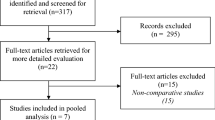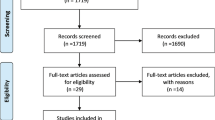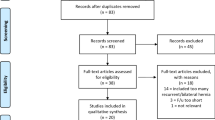Abstract
The present study systematically evaluated the clinical effects of mesh-plug and Lichtenstein herniorrhaphy in the treatment of primary inguinal hernia. PubMed, Embase, and the Cochrane Library (cut-off: May 25, 2020) databases were searched to select randomized controlled trials (RCTs) on mesh-plug and Lichtenstein herniorrhaphy for the treatment of primary inguinal hernia. Articles that met the inclusion criteria were screened and evaluated for quality. RevMan 5.3 software was used to perform a meta-analysis of operation time, discomfort in the inguinal region, haematoma, seroma, infection, time to return to normal activities, incidence of postoperative chronic pain, and recurrence rate. Eleven RCTs with 1457 patients in the mesh-plug group and 1472 in the Lichtenstein group were included. Meta-analysis showed that the mesh-plug herniorrhaphy group had a shorter operation time than the Lichtenstein herniorrhaphy group [P < 0.0001] but a longer time to return to normal activities after surgery [MD = 1.48, 95% CI (0.58, 2.38), P = 0.001]. There were no significant differences in postoperative discomfort in the inguinal region [P = 0.90], seroma [P = 0.10], haematoma [P = 0.27], infection [P = 0.40], incidence of postoperative chronic pain [P = 0.90], or recurrence rate [P = 0.77] between groups. Mesh-plug herniorrhaphy requires a shorter operation time than Lichtenstein herniorrhaphy, and there is no significant difference in postoperative complications or recurrence rate between the two methods. Clinical trial registration: INPLASY202070088. Meta-analysis of mesh -plug repair and Lichtenstein repair in the treatment of primary inguinal hernia










Similar content being viewed by others
References
Hernia Surge Group (2018) International guidelines for groin hernia management. Hernia 22:1–165. https://doi.org/10.1007/s10029-017-1668-x
Kockerling F, Simons MP (2018) Current concepts of inguinal hernia repair. Visc Med 34:145–150. https://doi.org/10.1159/000487278
Pukar M, Lakhani D (2014) Combination of liechtenstein repair with herniorrhaphy in open inguinal hernia repair- a prospective observational single center study. J Clin Diagn Res 8:N03–N08. https://doi.org/10.7860/JCDR/2014/10533.4926
Rutkow IM, Robbins AW (1993) “Tension-free” inguinal herniorrhaphy: a preliminary report on the “mesh plug” technique. Surgery 114:3–8
Campanelli G, Bruni PG, Morlacchi A, Lombardo F, Cavalli M (2017) Primary inguinal hernia: the open repair today pros and cons. Asian J Endosc Surg 10:236–243. https://doi.org/10.1111/ases.12394
Legutko J, Pach R, Solecki R, Matyja A, Kulig J (2008) The history of treatment of groin hernia. Folia Med Cracov 49:57–74
Jadad AR, Moore RA, Carroll D, Jenkinson C, Reynolds DJ, Gavaghan DJ, McQuay HJ (1996) Assessing the quality of reports of randomized clinical trials: is blinding necessary? Control Clin Trials 17:1–12. https://doi.org/10.1016/0197-2456(95)00134-4
Hozo SP, Djulbegovic B, Hozo I (2005) Estimating the mean and variance from the median, range, and the size of a sample. BMC Med Res Methodol 5:13. https://doi.org/10.1186/1471-2288-5-13
Bringman S, Ramel S, Heikkinen TJ, Englund T, Westman B, Anderberg B (2003) Tension-free inguinal hernia repair: TEP versus mesh-plug versus Lichtenstein: a prospective randomized controlled trial. Ann Surg 237:142–147. https://doi.org/10.1097/00000658-200301000-00020
Dalenback J, Andersson C, Anesten B, Bjorck S, Eklund S, Magnusson O, Rimback G, Stenquist B, Wedel N (2009) Prolene Hernia System, Lichtenstein mesh and plug-and-patch for primary inguinal hernia repair: 3-year outcome of a prospective randomised controlled trial. The BOOP study: bi-layer and connector, on-lay, and on-lay with plug for inguinal hernia repair. Hernia 13:121–129. https://doi.org/10.1007/s10029-008-0443-4 (Discussion 231)
Destek S, Gul VO (2018) Comparison of Lichtenstein repair and mesh plug repair methods in the treatment of indirect inguinal hernia. Cureus 10:e2935. https://doi.org/10.7759/cureus.2935
Droeser RA, Dell-Kuster S, Kurmann A, Rosenthal R, Zuber M, Metzger J, Oertli D, Hamel CT, Frey DM (2014) Long-term follow-up of a randomized controlled trial of Lichtenstein’s operation versus mesh plug repair for inguinal hernia. Ann Surg 259:966–972. https://doi.org/10.1097/SLA.0000000000000297
Frey DM, Wildisen A, Hamel CT, Zuber M, Oertli D, Metzger J (2007) Randomized clinical trial of Lichtenstein’s operation versus mesh plug for inguinal hernia repair. Br J Surg 94:36–41. https://doi.org/10.1002/bjs.5580
Karaca AS, Ersoy OF, Ozkan N, Yerdel MA (2015) Comparison of inguinal hernia repairs performed with lichtenstein, rutkow-robbins, and gilbert double layer graft methods. Indian J Surg 77:28–33. https://doi.org/10.1007/s12262-013-0809-4
Kingsnorth AN, Porter CS, Bennett DH, Walker AJ, Hyland ME, Sodergren S (2000) Lichtenstein patch or Perfix plug-and-patch in inguinal hernia: a prospective double-blind randomized controlled trial of short-term outcome. Surgery 127:276–283. https://doi.org/10.1067/msy.2000.104124
Mayagoitia JC, Chavez EP-D, Suarez D, Cisneros HA, Tene CE (2006) Predictive factors comparison of complications and recurrences in three tension-free herniorraphy techniques. Hernia 10:147–151. https://doi.org/10.1007/s10029-005-0057-z
Nienhuijs SW, van Oort I, Keemers-Gels ME, Strobbe LJ, Rosman C (2005) Randomized trial comparing the prolene hernia system, mesh plug repair and Lichtenstein method for open inguinal hernia repair. Br J Surg 92:33–38. https://doi.org/10.1002/bjs.4702
Sanders DL, Samarakoon DH, Ganshirt SW, Porter CS, Kingsnorth AN (2009) A two-centre blinded randomised control study comparing the Lichtenstein patch, Perfix plug and ProLoop plug in the repair of primary inguinal hernia. Hernia 13:499–503. https://doi.org/10.1007/s10029-009-0540-z
Sucullu I, Filiz AI, Sen B, Ozdemir Y, Yucel E, Sinan H, Sen H, Dandin O, Kurt Y, Gulec B, Ozyurt M (2010) The effects of inguinal hernia repair on testicular function in young adults: a prospective randomized study. Hernia 14:165–169. https://doi.org/10.1007/s10029-009-0589-8
Lichtenstein IL, Shulman AG (1986) Ambulatory outpatient hernia surgery. Including a new concept, introducing tension-free repair. Int Surg 71:1–4
Rutkow IM, Robbins AW (1995) Mesh plug hernia repair: a follow-up report. Surgery 117:597–598. https://doi.org/10.1016/s0039-6060(05)80263-6
Gilbert AI, Graham MF, Voigt WJ (1999) A bilayer patch device for inguinal hernia repair. Hernia 3:161–166. https://doi.org/10.1007/bf01195319
Salcedo-Wasicek MC, Thirlby RC (1995) Postoperative course after inguinal herniorrhaphy. A case-controlled comparison of patients receiving workers’ compensation vs patients with commercial insurance. Arch Surg 130:29–32. https://doi.org/10.1001/archsurg.1995.01430010031006
Liu Z, Xiong Z, Wu J, Wang F (2015) Clinical curative effect of mesalt combined with mepilex dressing in postoperative infection of inguinal hernia. Med Sci Monit 21:1038–1042. https://doi.org/10.12659/MSM.893095
Kockerling F, Bittner R, Jacob D, Schug-Pass C, Laurenz C, Adolf D, Keller T, Stechemesser B (2015) Do we need antibiotic prophylaxis in endoscopic inguinal hernia repair? Results of the herniamed registry. Surg Endosc 29:3741–3749. https://doi.org/10.1007/s00464-015-4149-2
Cobb WS, Carbonell AM, Kalbaugh CL, Jones Y, Lokey JS (2009) Infection risk of open placement of intraperitoneal composite mesh. Am Surg 75:762–767. https://doi.org/10.1177/000313480907500905 (discussion 767-768)
Reinpold W (2017) Risk factors of chronic pain after inguinal hernia repair: a systematic review. Innov Surg Sci 2:61–68. https://doi.org/10.1515/iss-2017-0017
Kockerling F, Koch A, Lorenz R, Schug-Pass C, Stechemesser B, Reinpold W (2015) How long do we need to follow-up our hernia patients to find the real recurrence rate? Front Surg 2:24. https://doi.org/10.3389/fsurg.2015.00024
Author information
Authors and Affiliations
Contributions
MY and W-XX designed the study. SL ran the search strategy. L-YH collected data. D-CW and MY re-checked data. SL and L-YH performed analyses and D-CW checked the analyses. MY and L-YH assessed the quality of studies, and D-CW confirmed the quality. MY wrote the manuscript, and W-XX edited the manuscript. All listed authors reviewed and revised the manuscript.
Corresponding author
Ethics declarations
Conflicts of interest
The authors have no conflicts of interest to declare that are relevant to the content of this article.
Research involving human participants and/or animals
This article does not contain any studies with human participants or animals performed by any of the authors.
Informed consent
Informed consent is not required for this type of study.
Additional information
Publisher's Note
Springer Nature remains neutral with regard to jurisdictional claims in published maps and institutional affiliations.
Rights and permissions
About this article
Cite this article
Yu, M., Xie, WX., Li, S. et al. Meta-analysis of mesh-plug repair and Lichtenstein repair in the treatment of primary inguinal hernia. Updates Surg 73, 1297–1306 (2021). https://doi.org/10.1007/s13304-021-01032-4
Received:
Accepted:
Published:
Issue Date:
DOI: https://doi.org/10.1007/s13304-021-01032-4




